Submitted:
17 May 2023
Posted:
18 May 2023
You are already at the latest version
Abstract
Keywords:
1. Introduction
2. Study area
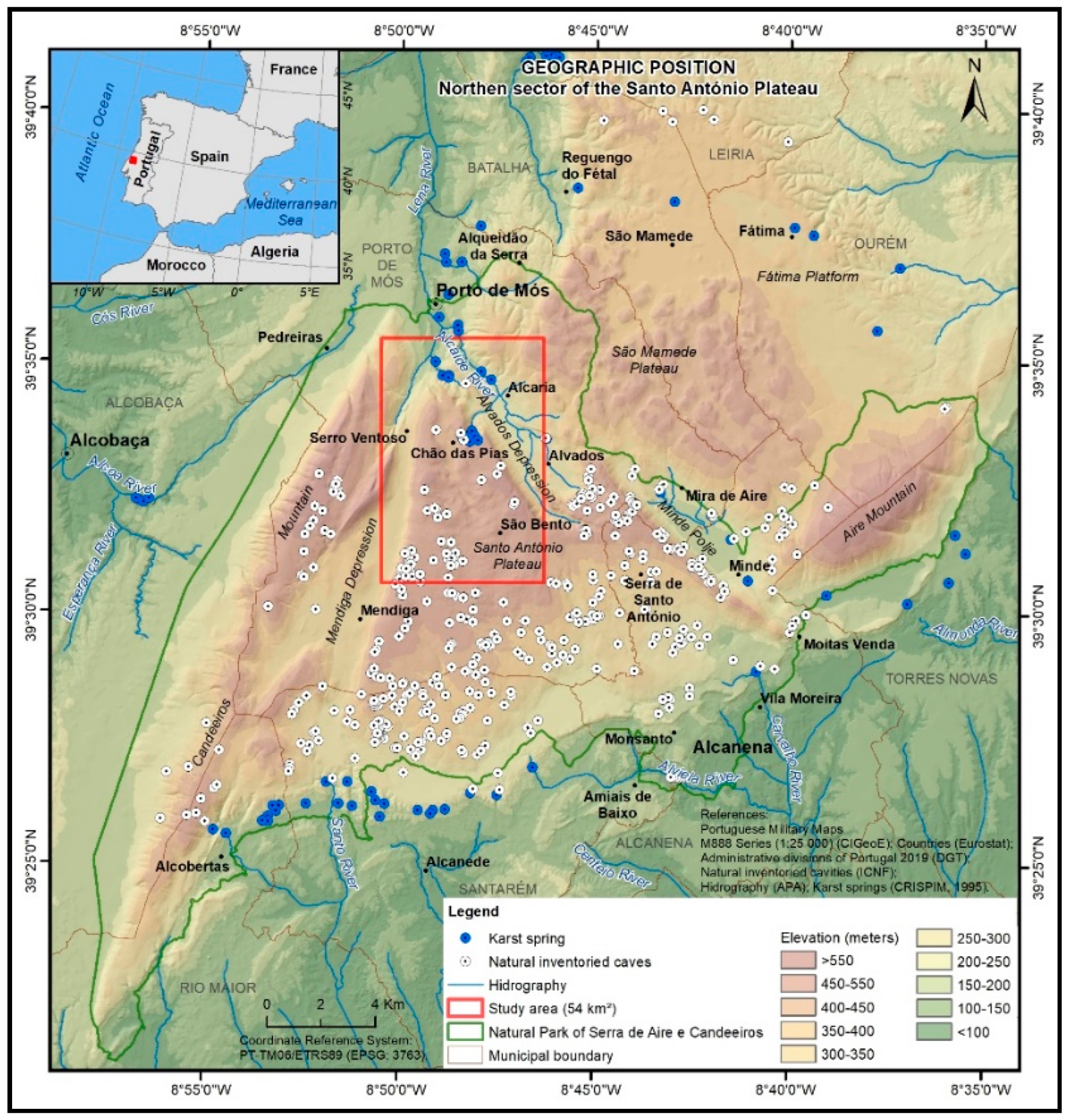
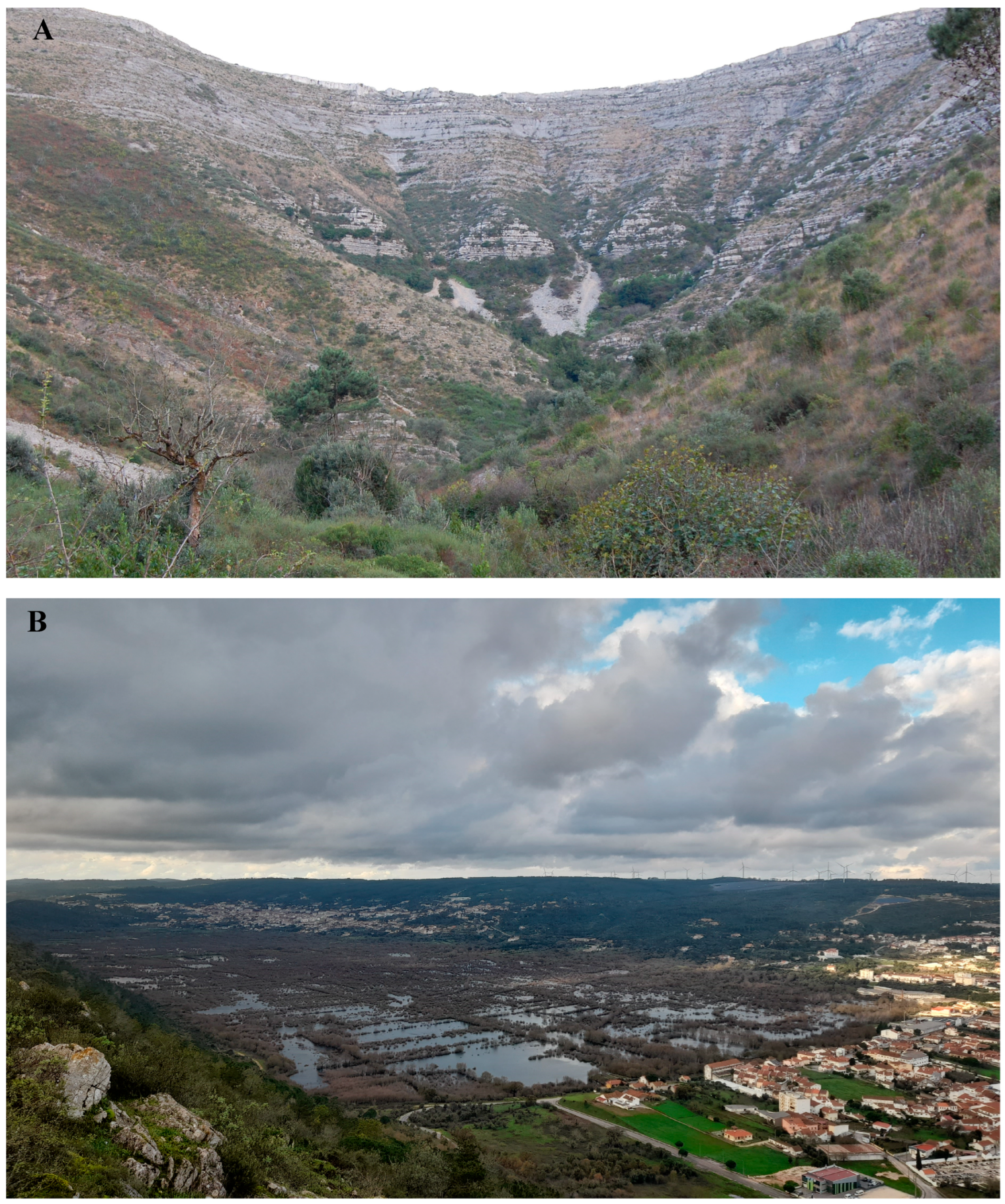
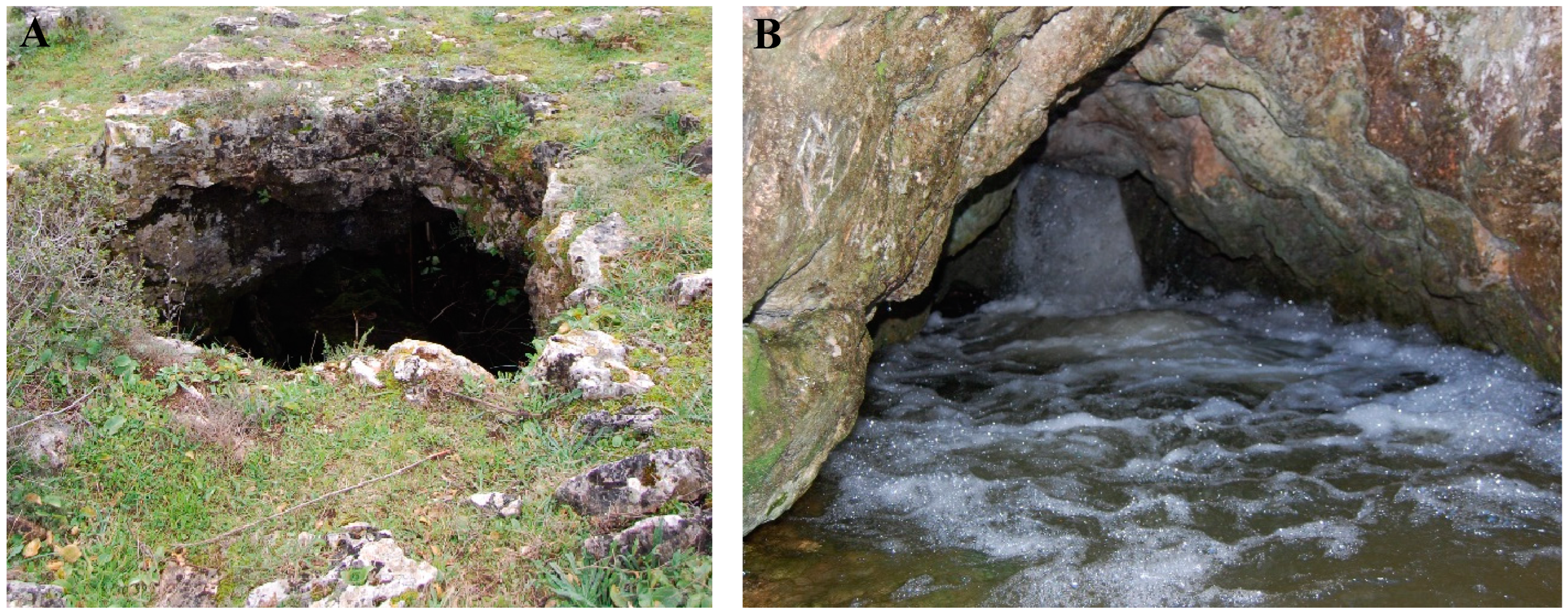
3. Material and methods
3.1. Data collection and pre-processing
| Classification | Data collection of the study area | Derived raster thematic layer | ||
| (spatial database) | GIS data type | Scale or resolution | Source or citation | (Conditioning factor) in a GIS |
| Geological data | Lithology (polygon-vector)A | 1:50 000 | IGM (1998) | Lithostratigraphic units |
| Strata geometry (point-vector) | 1:50 000 | Carvalho (2013) | ||
| Tectonic structures (line-vector) | 1:50 000 | Carvalho (2013) | Fracture density | |
| Topographic data | Contours (line-vector)B | 1:10 000 | PMM (2020) | Relief energy |
| Points elevation (point-vector)B | 1:10 000 | PMM (2020) | ||
| Hydrogeological data | Drainage sectors (polygon-vector) | 1:50 000 | Crispim (1995) | |
| Karst springs (point-vector) | 1:50 000 | Crispim (1995) | ||
| Vegetation cover data | Land cover (polygon-vector)C | 1:25 000 | DGT (2018) | Land cover |
| Speleological data | Karstic cave entrances (point-vector)D | 1:100 000 | ICNF (2021) | Location of known cave entrances |
| AVector data digitalised on Geological Map of Portugal 27-A Vila Nova de Ourém (courtesy of Porto de Mós Municipality - PMM). IGM = Instituto Geológico e Mineiro. | ||||
| BVector data from approved cartography was used to generate a digital elevation model (DEM, 5-m pixel). | ||||
| CAvaliable by Direção-Geral do Território (DGT) at: https://www.dgterritorio.gov.pt/Carta-de-Uso-e-Ocupacao-do-Solo-para-2018 (accessed on 31 May 2021). | ||||
| DAvaliable by local speleological teams through the Instituto da Conservação da Natureza e das Florestas, IP de Portugal (ICNF). | ||||
3.2. Model-building strategy
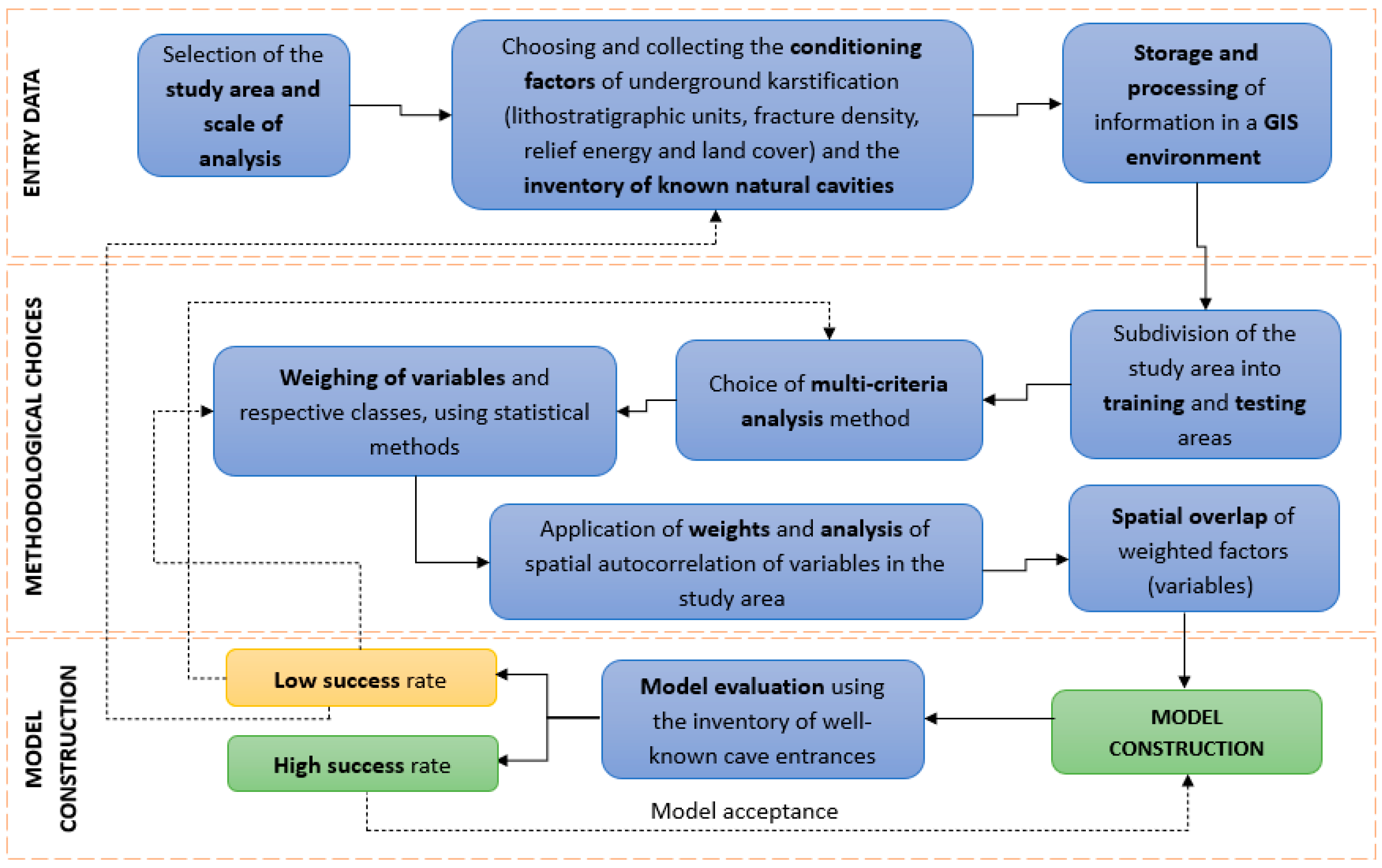
| DesignationA |
Lithology | SCB | Facies | Granulometry, texture and qualitative (apparent) porosityC | SC | StratonomyD | SC | Bed geometryE | SC | Σ - (qualitative assessment)F |
|---|---|---|---|---|---|---|---|---|---|---|
| Alluvium (a); detrital unit and terra rossa of Estremadura Limestone Massif (A) | Siliciclastic deposits, sometimes with a marly component | 0 | Pelitic and sandy facies | Pelites and sands with a generally clast-supported texture. Excellent porosity (evaluated based on the type of lithology, granulometry and texture). | 0,9 | Not show an apparent organisation in sedimentary beds but rather a massive structure filling the valley bottoms (alluvium) and some depressions and crevices of a karst nature (siliciclastic deposits with terra rossa). | 0 | - | 0 | 0,9 (Very low) |
| Beds of Alcobaça (J3AI) | Marls, sometimes siltstones, limestones, and sandstones | 0,2 | Mudstones, silty-sandy carbonate clays and silty-clay sandstones | Pelites to matrix-supported sands containing various fossiliferous associations. Poor porosity (evaluated based on the type of lithology, granulometry and texture). |
0,2 | From base to ~57 m (thick beds of silty-sandy clays and silty-clay sandstones); 57 to 102 m (beds of sandstones (~30 m), sometimes fine or coarse, micaceous and silt-sandy clays, forming finer intercalations (1 to 5 m); 102 to 215 m (micaceous sandstones - ~113 m), from fine to very fine, grey and micaceous silt-sandy clays, grey green, with calcareous concretions, sometimes ferruginous); 215 to 269 m (silt-sandy carbonated clays - ~54 m), with fine calcareous intercalations); >269 m (micritic limestones). |
0,2 | Thickness about 150 to 200 m; average slope 25º (min. 15º and max. 38º). |
0,3 | 0,9 (Very low) |
| Cabaços and Montejunto beds (J3CM) |
Clay limestones and marls | 0,4 | Mudstones/wackstones related with rare packstones and grainstones. | Clay micritic limestones, limestones associated with marl, microsparitic limestones, bioclastic pelimicritic limestones. Less than 10% grain > 2mm; presence of carbonated microcrystalline matrix; non-contact grains (matrix-supported texture). Poor porosity (evaluated based on the type of lithology, granulometry and texture). |
0,4 | Base with 3 m (limestone at the base and yellowish marls with ferruginous concretions); 6 m (very bioclastic pelmicritic clayey limestone); 0.40 m (clay-limestone); 0.50 m (clay micritic limestone); 20 m (intraclastic micritic limestone); 2 m (a monogenic conglomerate of limestone matrix, compact)? (microsparite limestone, with peloids and intraclasts); 30 m (very bioclastic pelmicritic limestone). |
0,3 | Thickness about 65 m; average slope 34º (min. 8º and max. 85º). | 0,2 | 1,3 (Very low) |
| Limestones of Moleanos (J2MI) |
Limestones |
0,5 | Lithofacies 2 - rudstones; grainstones; Oolitic/bioclastic/ oncolytics/lithoclastics packstones |
More than 10% grain > 2mm; Absence of carbonated crystalline matrix; grains in contact (grain-supported texture). Porosity evaluated by INÊS (2010): from poor to excellent. |
0,7 | Base 20-30 m (alternations of well-calibrated oolitic limestones and coarser calciclastics, sometimes with erosive base levels); 35-40 m (more compact, pelbiomicritic limestones); top; >100 m (succession becomes more clastic, with massive levels of calciclastic limestones). |
0,6 | Thickness is about 150 meters, probably 180-200 meters; average slope between 20 to 25º. | 0,6 | 2,4 (High) |
| Micritic limestone of Serra de Aire (J2SA) |
Limestones | 0,8 | Lithofacies 6 – Mudstones and wackstones oncolíticos with fenestrae and laminations (idem). Lithofacies 7 - Floastones, wackstones and mudstones with algal/oncoid nodules and rusting. |
Dolomitic levels; micritic and dolomicritic limestones (compact or laminar). Less than 10% grain > 2mm; presence of carbonated microcrystalline matrix; non-contact grains; more than 10% grain > 2mm and non-contact grain. Poor for Lithofacies 6 and Poor to Reasonable for Lithofacies 7. |
0,8 | Base 50 m (cyclical sequences of micritic dolomitic limestones and limestones, fenestrated decimetric layers; laminar dolomicrites); <150 m (compact micritic, fenestrated or oncolitic limestones, with ferruginous tinges, in 40-50 cm to metric layers); >150 m (decreased fenestrated and oncosparitic limestones, becoming fossiliferous micritic limestones; biomicritic or pelimicritic limestones). |
0,9 | Thickness from 350 to 400 m; average slope 14º (min. 2º and max. 70º). | 0,8 | 3,3 (Very high) |
| Bioclastic limestone of Codaçal (J2Co) |
Limestones | 0,7 | Lithofacies 1 – Grainstones oolitic and bio-intraclastic with oblique bedding (idem). Lithofacies 2 - Rudstones, grainstones and bioclastic/oncolytic/lithoclastics packstones. |
Biolclastic and oobioclastic and sporadically dolomitized limestones. More than 10% grain > 2mm; Absence of carbonated crystalline matrix; grains in contact. Poor to fair for Lithofaces 1 and poor to excellent for Lithofaces 2. |
0,8 | Base 8-10 m (well calibrated fine oolitic limestones with small-scale oblique lamination/stratification (0.5-2cm and 16-28º), millimetric hardground 5 m from the base); 5 m (fragmented and/or bioperforated micritic coatings at the base of laminae of oblique stratified bundles of oolitic limestones (10-13 cm and 18-20 cm); 10 m (bioclastic and oolitic limestones with intraclasts, oblique stratification with 12º and 22º); 5-6 m (bioclastic and oolitic limestones with average thickness of oblique bedding bundles: 30-40 cm to 70-100 cm). |
0,5 | Average thickness is about 50 to 60 m, with a tendency to increase to 70-80 m; average slope 8º (min. 5º and max. 10º). | 0,9 | 2,9 (High) |
| Limestones of Chão das Pias (J2CP) |
Slightly clayey or marly limestone, limestone, dolomitic limestone | 0,7 | Lithofacies 9a – Mudstones, wackstones and bioclastic packstones (compact limestone) (ibidem). | Less than 10% grain > 2mm; Presence of carbonated microcrystalline matrix; non-contact grains; Absence of carbonated microcrystalline matrix and grains in contact. Poor porosity evaluated. |
0,8 | First 15 m (slightly clayey or marly limestone in decimeter benches with siliceous nodules); At 40 m from the top the nodules become larger (botryoidal). Succession characterized by the alternation of micritic and calciclastic limestones. |
0,7 | Thickness about 50-60 m, reaching, however, values >80 m? Average slope 9º (min. 5º and max. 15º). |
0,9 | 3,1 (Very high) |
| Marls and marly limestones of Zambujal (J2ZA) |
Marls, marly limestones, clayey limestones, limestones. | 0,4 | Lithofacies 9a – Mudstones, wackstones and bioclastic packstones (compact limestones). Lithofacies 9b – Mudstones, wackstones and bioclastic packstones (limestones, marl-clay limestones, and marls). |
Less than 10% grain > 2mm; Presence of carbonated microcrystalline matrix. Non-contact grains; absence of carbonated microcrystalline matrix and grains in contact. Poor porosity. |
0,8 | Rhythmic alternation of marls, marly limestones, and clayey limestones, in almost always thin layers. The succession becomes increasingly thick (decimetric to metric layers) and calcareous from the bottom to the top until the marly levels disappear. It appears significantly fractured. | 0,7 | Thickness about 220-250 m; average slope 14º (min. 4º and max. 34º). | 0,8 | 2,7 (High) |
| Marl limestones and marls of Fórnea (J1-2Fo) |
Marls and marly limestones | 0,4 | Grumose; wackstones; biomicrites to biosparites/grainstone; packstones to grainstones. |
Less than 10% grain > 2mm/More than 10% grain > 2mm; Presence of carbonated microcrystalline matrix; non-contact grains/absence of carbonated microcrystalline matrix and grains in contact. Poor to reasonable porosity (evaluation by type of lithology and texture). |
0,7 | Succession dominated by thin to medium layers, centimeter to decimeter, sometimes without rhythmic organization. At 80 m from the top occurrence of biostromal bodies with metric thickness. The upper 50 m are dominated by micritic limestones. | 0,7 | Maximum thickness with about 220-250 m; average slope 33º (min. 19º and max. 58º). | 0,5 | 2,3 (Moderate) |
| Beds of Coimbra (J1Co) |
Dolomites | 0,5 | Wackstones to grainstones. | Less than 10% grain > 2mm/More than 10% grain > 2mm; Presence of carbonated microcrystalline matrix; non-contact grains/absence of carbonated microcrystalline matrix and grains in contact. Poor to reasonable porosity (evaluation by type of lithology and texture). |
0,7 | Cross-bedding and dolomites with parallel or wavy lamination, interstratified with pellets. | 0,4 | Thickness about 60 m (beds with vertical or slightly inverted slopes). | 0,1 | 1,7 (Moderate) |
| Platelet dolomites (J1pi) |
Dolomitic limestones | 0,7 | Mudstone | Micritic dolomitic limestone. Poor porosity (evaluated based on the type of lithology). |
0,2 | Layers with centimeter to decimeter thickness. | 0,1 | Thickness about 30-40 m. | 0,2 | 1,2 (Low) |
| Marls of Dagorda (J1Da) |
Sandy loams, gypsum and saliferous clays, Intercalations of dolomitic limestones | 0,1 | Sandy, pelitic and Mudstones facies for the carbonate ones. | Poor porosity (evaluated based on the type of lithology). | 0,1 | 250-320 m (dolomitic member, essentially dolomitic or margo-dolomitic with red and/or greyish pelites and evaporites); 60-850 m (saliferous/dolomitic member, predominantly dolomitic and/or limestone and marl rich in evaporites - anhydrite and halite); 290-800 m (saliferous member, characterised by an accentuated domain of halite, sometimes interstratified with dolomitic marls and/or marly pelites and anhydrite); From about 1000 m (occurrence of “Dolomites in platelets”); 1600-1200 m (evaporitic salts with intercalations of evaporitic syngenetic dolomite and gypsum); ~3000-1600 m (thick saliferous series with frequent clayey intercalations, also saliferous, containing anhydrite inclusions); |
0,1 | Formation subjacent Jurassic limestones with significant thickness, >3000 m, according to sounding “São Mamede 1”. | 0,4 | 0,7 (Very low) |
| Eruptive rocks |
Dolerite | 0 | - | Poor porosity (evaluated based on the type of lithology). | 0 | Associated with fractures or discontinuities. | 0,8 | - | 0 | 0,8 (Very low) |
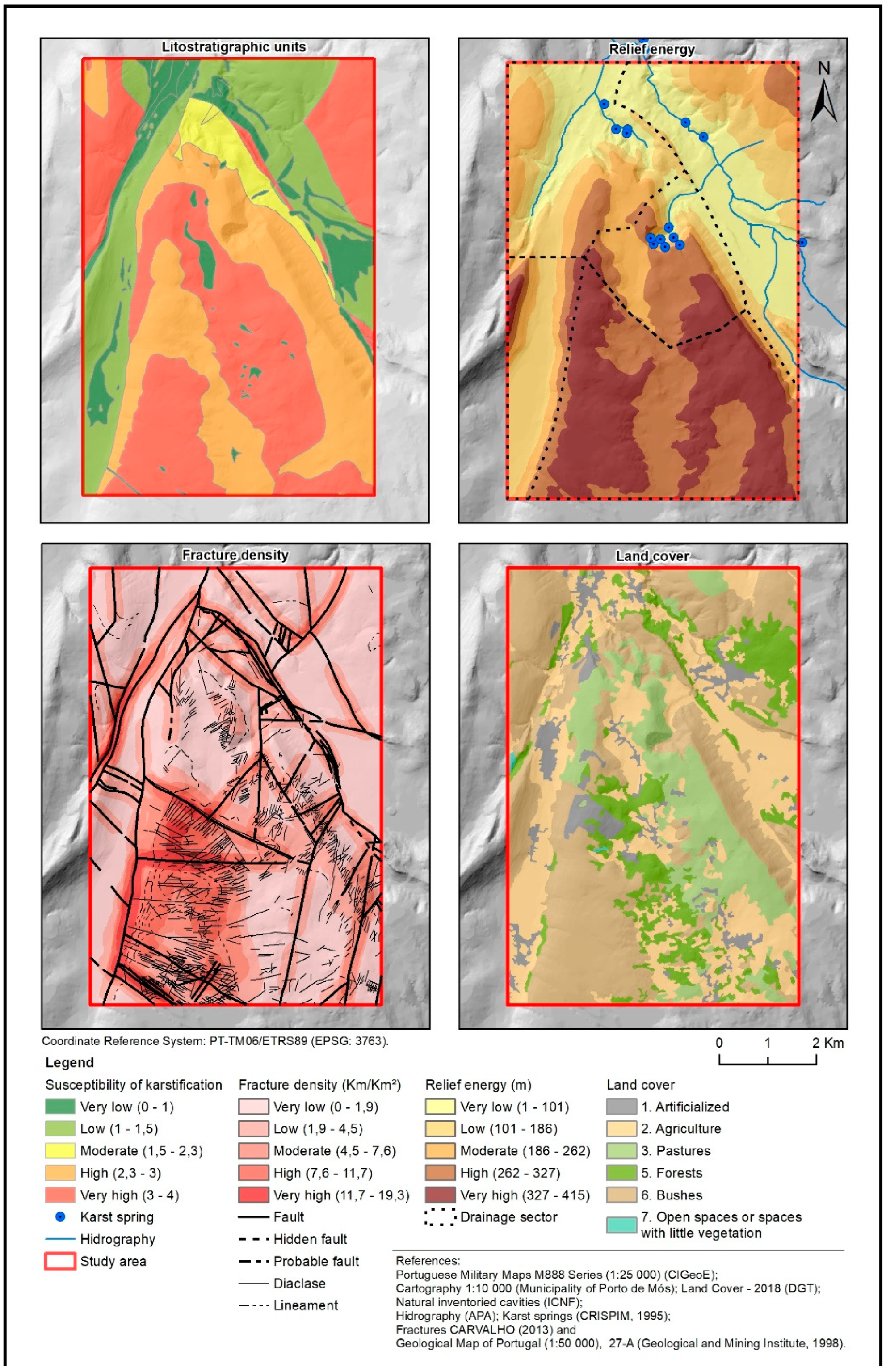
| Lithostratigraphic units (SK*) | Very high | High | Moderate | Low | Very low | |
| Very high | 1 | 2 | 5 | 7 | 9 | 0,46 |
| High | 1/2 | 1 | 4 | 6 | 8 | 0,32 |
| Moderate | 1/5 | 1/4 | 1 | 3 | 6 | 0,13 |
| Low | 1/7 | 1/6 | 1/3 | 1 | 3 | 0,06 |
| Very low | 1/9 | 1/8 | 1/6 | 1/3 | 1 | 0,03 |
| CR = 0,055 * susceptibility of karstification | ||||||
| Fracture density | Very high | High | Moderate | Low | Very low | |
| Very high | 1 | 2 | 4 | 6 | 9 | 0,47 |
| High | 1/2 | 1 | 3 | 4 | 7 | 0,30 |
| Moderate | 1/4 | 1/3 | 1 | 2 | 3 | 0,12 |
| Low | 1/6 | 1/4 | 1/2 | 1 | 1 | 0,07 |
| Very low | 1/9 | 1/7 | 1/3 | 1 | 1 | 0,05 |
| CR = 0,013 | ||||||
| Relief energy | Very high | High | Moderate | Low | Very low | |
| Very high | 1 | 1 | 2 | 3 | 4 | 0,32 |
| High | 1 | 1 | 2 | 3 | 4 | 0,32 |
| Moderate | 1/2 | 1/2 | 1 | 2 | 3 | 0,19 |
| Low | 1/3 | 1/3 | 1/2 | 1 | 1 | 0,09 |
| Very low | 1/4 | 1/4 | 1/3 | 1 | 1 | 0,08 |
| CR = 0,007 | ||||||
| Land Cover | Forests | Pastures | Agriculture | Bushes | Open spaces or with little vegetation | Artificialised territories | |
| Forests | 1 | 2 | 3 | 3 | 3 | 8 | 0,35 |
| Pastures | 1/2 | 1 | 1 | 2 | 3 | 8 | 0,22 |
| Agriculture | 1/3 | 1 | 1 | 2 | 2 | 6 | 0,18 |
| Bushes | 1/3 | 1/2 | 1/2 | 1 | 1 | 7 | 0,11 |
| Open spaces or with little vegetation | 1/3 | 1/3 | 1/2 | 1 | 1 | 7 | 0,11 |
| Artificialised territories | 1/8 | 1/8 | 1/6 | 1/7 | 1/7 | 1 | 0,03 |
| CR = 0,035 | |||||||
| Karstification factors | Lithostratigraphic units | Fracture density | Relief energy | Land cover | |
| Lithostratigraphic units | 1 | 2 | 4 | 5 | 0,49 |
| Fracture density | 1/2 | 1 | 3 | 4 | 0,31 |
| Relief energy | 1/4 | 1/3 | 1 | 2 | 0,13 |
| Land cover | 1/5 | 1/4 | 1/2 | 1 | 0,08 |
| CR = 0,018 | |||||
4. Results and discussion
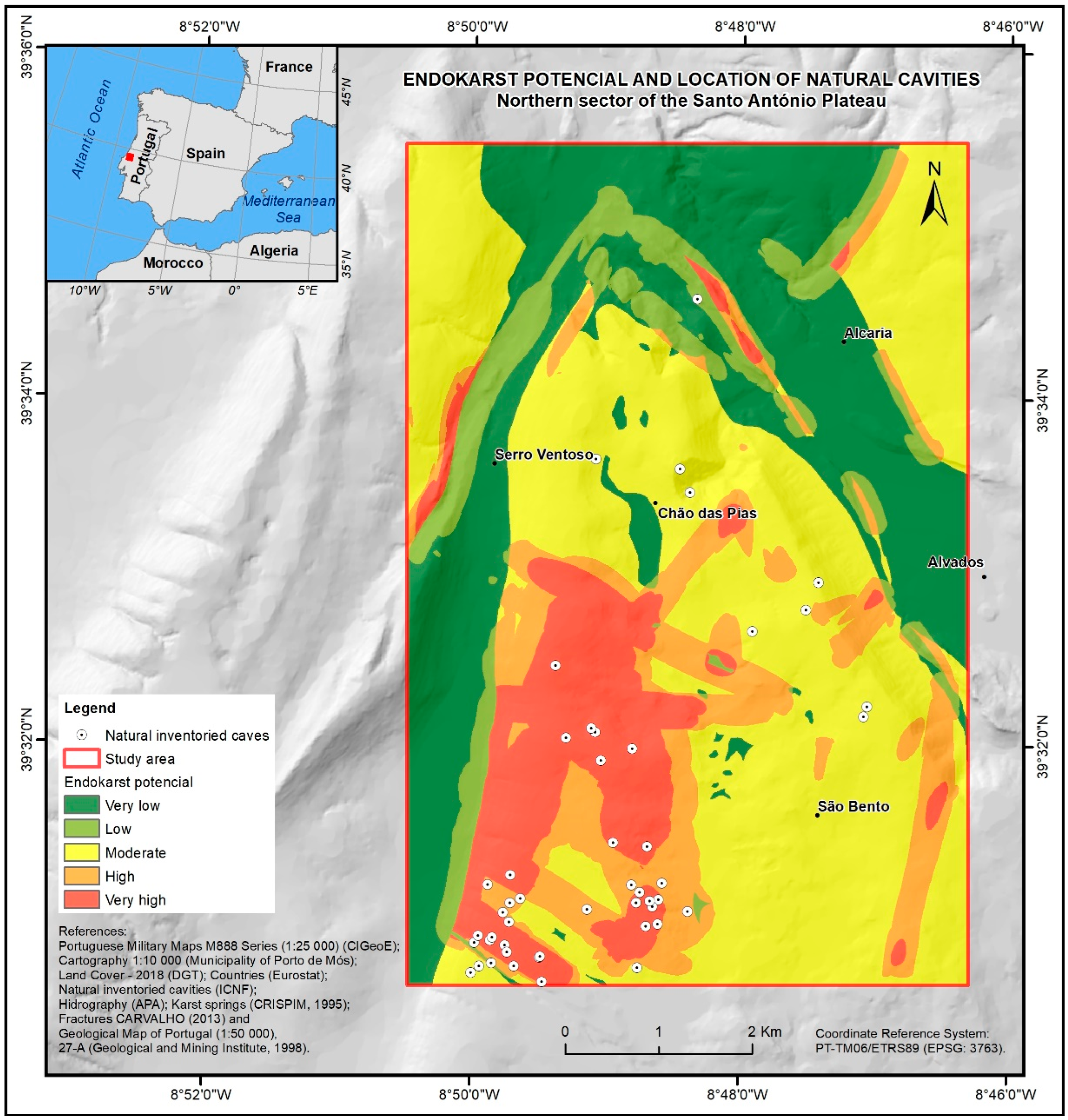
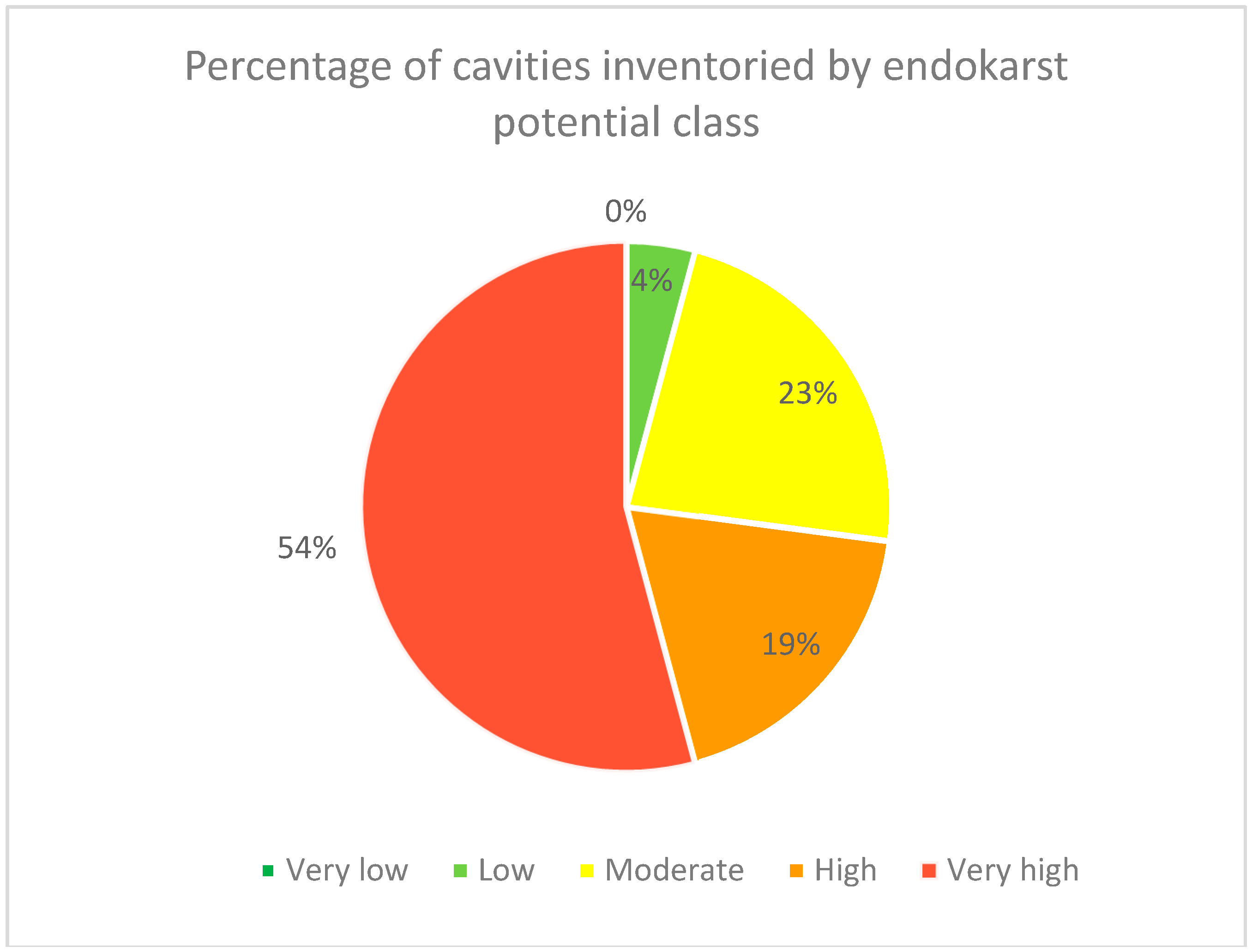
| Factors (criteria) | Classes | Area (km2) | N.º caves | N. º caves/Km2 |
|---|---|---|---|---|
| Fracture density |
Very low | 21,99 | 5 | < 1 |
| Low | 14,67 | 6 | < 1 | |
| Moderate | 9,55 | 11 | 1,15 | |
| High | 5,24 | 19 | 3,63 | |
| Very high | 2,55 | 7 | 2,75 | |
| Relief energy |
Very low | 11,66 | 0 | 0 |
| Low | 9,89 | 2 | < 1 | |
| Moderate | 8,15 | 1 | < 1 | |
| High | 11,81 | 9 | < 1 | |
| Very high | 12,49 | 36 | 2,88 | |
| Land cover | Forests | 7,22 | 2 | < 1 |
| Pastures | 7,81 | 4 | < 1 | |
| Agriculture | 14,71 | 1 | < 1 | |
| Bushes | 20,54 | 40 | 1,95 | |
| Open spaces or with little vegetation | 0,08 | 0 | 0 | |
| Artificialised territories | 3,64 | 1 | < 1 |
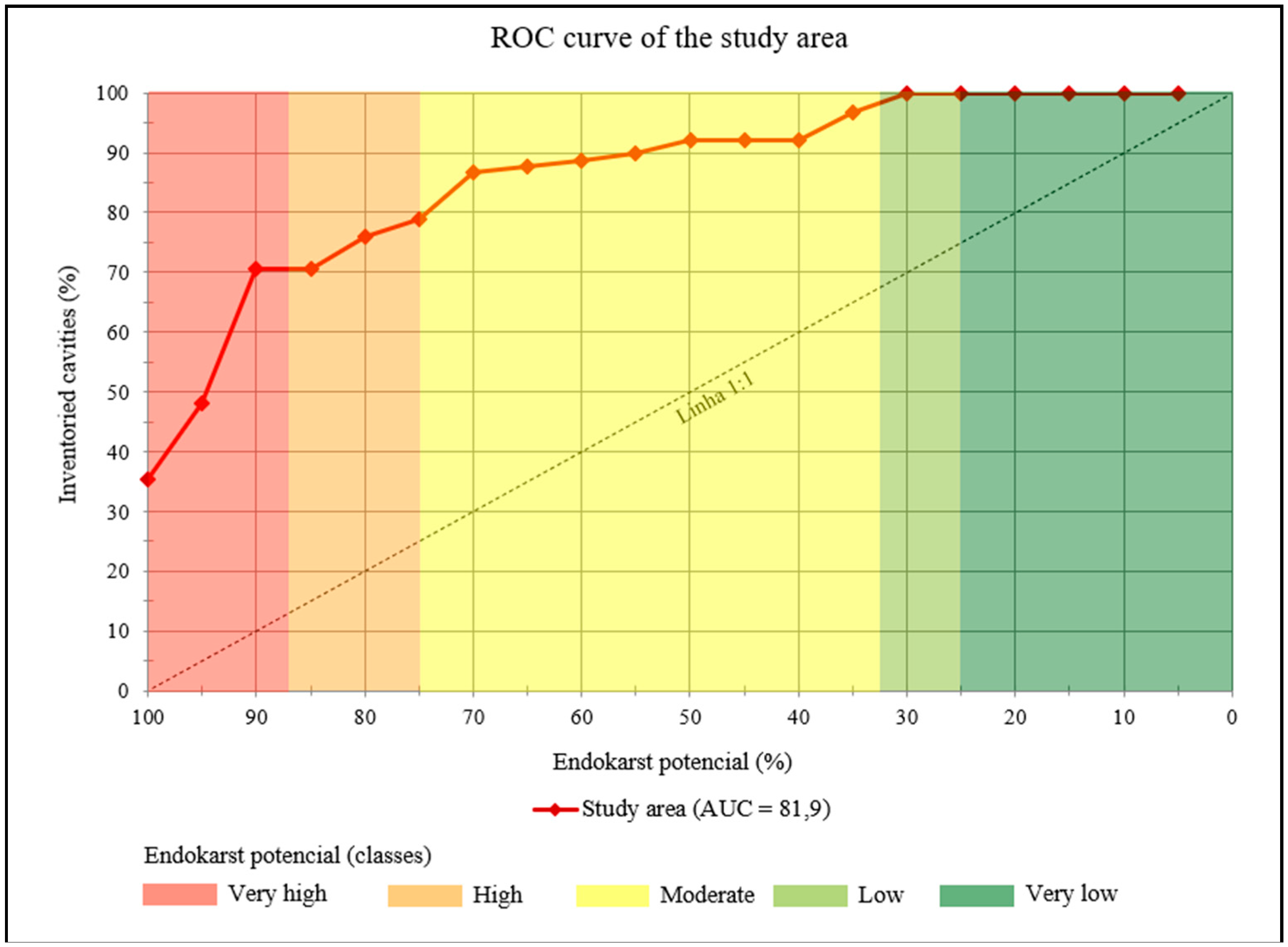
5. Conclusions
Author Contributions
Funding
Acknowledgments
Conflicts of Interest
References
- Abdellah, A.B., Jamila, R., Ahmed, B., Elhassan, L., Samir, N. (2022). The Karst Landscapes of Beni Mellal Atlas (Central Morocco): Identification for Promoting Geoconservation and Tourism. Quaestiones Geographicae, Vol.41(3), pp.87-109.
- Aleksandar, A., Nemanja,T., Slobodan, M. (2019). Karst geoheritage and geotourism potential in the Pek River lower basin (eastern Serbia). Geographica Pannonica, Vol. 23 (1), pp. 32-46.
- Azerêdo, A.C. (1993). Jurássico Médio do Maciço Calcário Estremenho (Bacia Lusitânica): análise de fácies, micropaleontologia, paleogeografia. Tese de Doutoramento, Departamento de Geologia da Faculdade de Ciências da Universidade de Lisboa, 366 p.
- Azerêdo, A.C. (1998). Geometry and facies dynamics of Middle Jurassic carbonate ramp sandbodies. West-Central Portugal, University of Birmingham, 34 p.
- Azerêdo, A.C. (2007). Formalização da litostratigrafia do Jurássico Inferior e Médio do Maciço Calcário Estremenho (Bacia Lusitânica). Comunicações Geológicas, t. 94, pp. 29-51.
- Ballesteros, D., Fernández-Martínez, E., Carcavilla, L., Jiménez-Sánchez, M. (2019). Karst Cave Geoheritage in Protected Areas: Characterisation and Proposals of Management of Deep Caves in the Picos de Europa National Park (Spain). Geoheritage 11, pp. 1919–1939.
- Barton, H.A. (2013). Biospeleogenesis. Treatise on Geomorphology, J. Shroder (Editor in Chief), A. Frumkin (Editor), Academic Press, San Diego, CA Vol. 6, Karst Geomorphology, pp. 38-56.
- Bennett, B., Ibrahim, A.M. (2014). The Assessment of Machine Learning Model Performance for Predicting Alluvial Deposits Distribution. Procedia Computer Science 36, pp. 637-642.
- Bi, J., Bennett, K.P. (2003). Regression Error Characteristic Curves. Proceedings of the Twentieth International Conference on Machine Learning (ICML-2003), Washington DC, pp. 43-50.
- Bolstad, P. & Manson, S. (2022). Chapter 13: Spatial Models and Modeling. In GIS fundamentals: A first text on geographic information systems, 7th ed., Eider Press, pp. 561-582.
- Brilha, J. (2005). Património geológico e geoconservação a conservação da natureza na sua componente geológica. Palimage, Viseu, 190 p.
- Canais, F., Fernandes, J. (1999). Lapas e Algares da Serra de Santo António. SubTerra - Grupo de Espeleologia 187 p.
- Carvalho, J.M. (2013). Tectónica e caraterização da fraturação do Maciço Calcário Estremenho, Bacia Lusitânica. Contributo para a prospeção de rochas ornamentais e ordenamento da atividade extrativa. Tese de Doutoramento, Departamento de Geologia da Faculdade de Ciências da Universidade de Lisboa, 443 p.
- Chiarini, V., Duckeck, J., De Waele, J. A. (2022). Global Perspective on Sustainable Show Cave Tourism. Geoheritage 14 (82), 27 p.
- Church, R. L. (2002). Geographical information systems and location science. Computers and Operations Research 29 (6), pp. 541–562.
- Crispim, J.A. (1992). Características cársicas das rochas carbonatadas da região central do Maciço Calcário Estremenho. Algar, Boletim da Sociedade Portuguesa de Espeleologia 3, Lisboa, pp. 9-18.
- Crispim, J.A. (1995). Dinâmica cársica e implicações ambientais nas depressões de Alvados e Minde. Tese de Doutoramento em Geologia, Faculdade de Ciências da Universidade de Lisboa, 388 p.
- Cunha, L. (1988). As Serras Calcárias de Condeixa-Sicó-Alvaiázere. Estudo de Geomorfologia. Tese de Doutoramento, Faculdade de Letras da Universidade de Coimbra, 325 p.
- Cunha, L. (1993). Geomorfologia estrutural e cársica. O Quaternário em Portugal, Balanço e Perspectivas, Colibrí, Lisboa, pp. 63-74.
- Cunha, L., Dimuccio, A., L., Aubry, T. (2014). Património cársico no Centro de Portugal. O caso do Maciço de Sicó. Património Geomorfológico e Geoconservação. Experiências em Portugal e no Brasil, Atas/proceedings do I Encontro Luso-Brasileiro de Património Geomorfológico e Geoconservação, pp. 27-34.
- Cunha, L., Dimuccio, A., L., Paiva, I. (2018). Geopatrimónio cársico e desenvolvimento local no Maciço de Sicó. Desafios para afirmar a Lusofonia na Geografia Física e Ambiente, II Encontro Luso-Afro-Americano de Geografia Física e Ambiente, pp.1227-1233.
- Daveau, S. (2004). O Relevo de Portugal. Grandes Unidades Regionais. In: Feio, M. & Daveau, S. (Organizadores), Coimbra, Associação Portuguesa de Geomorfólogos, pp. 61-73.
- De Smith, M.J., Goodchild, M.F., & Longley, P.A. (2018). Geospatial analysis and model building. In Geospatial Analysis: A Comprehensive Guide to Principles, Techniques and Software Tools, 6th ed., 618 p.
- Ferreira, A.B., Rodrigues, M.L., Zêzere, J.L. (1988). Problemas da Evolução Geomorfológica do Maciço Calcário Estremenho. Finisterra, XXIII, Vol. 23 (45), Lisboa, pp. 5-28.
- Fielding, A.H., Bell, J.F. (1997). A review of methods for the assessment of prediction errors in conservation presence/absence models. Environmental Conservation, Vol. 24 (1), pp. 38-49.
- Figueiredo, R.F. (2001). Modelação cartográfica em ambiente SIG para apoio à decisão: aplicação ao estudo da afectação potencial de usos do solo no sector Norte do Maciço Marginal de Coimbra. Dissertação de mestrado em Geografia Física e Estudos Ambientais, Faculdade de Letras da Universidade de Coimbra, 204 p.
- Fleury, E. (1925). Portugal Subterrâneo, Ensaio de espeleologia portuguesa. Coleção Natura, Lisboa, 45 p.
- Ford, D., Williams, P. (2007). Karst Geomorphology and Hydrology. John Wiley & Sons, Ltd, 562 p.
- Gao, J. (2021). Fundamentals of Spatial Analysis and Modelling, 1st ed., CRC Press, 368 p.
- Goepel, K. (2018). AHP Excel Template with multiple Inputs. Version AHPcalc-v2018-09-15.
- Ghung, C.F. Fabbri, A.G. (2003). Validation of Spatial Prediction Models for Landslide Hazard Mapping. Natural Hazards 30, pp. 451-472.
- Guzzetti, F., Reichenbach, P., Cardinali, M., Galli, M., Ardizzone, F. (2005). Probabilistic landslide hazard assessment at the basin scale. Geomorphology 72, pp. 272–299.
- Hämäläinen, R.P., Salo, A.A. (1997). The Issue is Understanding the Weights. Journal of Multi-Criteria Decision Analysis, Vol. 6, pp. 340-343.
- Hobléa, F. (2004). Expertise et médiation scientifique pour la gestion durable de l’environnement karstique. Actes de la réunion annuelle de la Société Suisse de Géomorphologie (SSGm), Gestion durable de l’environnement karstique, pp. 25–42.
- Huang, B. (2018). Comprehensive geographic information systems (Huang, B., Editor in Chief). Vol. 1, GIS methods and techniques. Vol. Editors: Thomas J.C., Ming-Hsiang T., Elsevier, 439 p.
- Inês, N. (2010). Paleotipologias diagenéticas em formações carbonatadas do Jurássico Médio da Bacia Lusitânica: análise multiscala e aplicações à caraterização de reservatórios. Dissertação de Mestrado na Área de especialização: Estratigrafia, Sedimentalogia e Palentologia, Departamento de Geologia da Faculdade de Ciências da Universidade de Lisboa, 230 p.
- Ishizaka, A., Labib, A. (2009). Analytic Hierarchy Process and Expert Choice: Benefits and limitations. Operational Reasearch Society, Vol. 22, 4, pp. 201-220.
- James, N.P., Choquette, P.W. (1984). Diagenesis 9, Limestones - The Meteoric Diagenetic Environment. Carbonate Sedimentology and Petrology, Vol. 4, pp. 45-78.
- Khalaf, E.E.D.A.H. (2022). Karst Heritage as a Tourist Attraction: a Case Study in the White Desert National Park, Western Desert, Egypt. Geoheritage 14 (94) (2022), 30 p.
- Klimchouk, A., Ford, D., Palmer, A., Dreybrodt, W. (2000). Spleogenesis, Evolution of Karst Aquifers. National Speleological Society January 2000 Edition, 527 p.
- Kullberg, J.C. Rocha, R.B., Soares, A.F., Rey, J., Terrinha, P., Axerêdo, A.C., Callapez, P., Duarte, L.V., Kullberg, M.C., Martins, L., Miranda, R., Alves, C., Mata, J., Madeira, J., Mateus, O., Moreira, M., Nogueira, C.R. (2013). A Bacia Lusitaniana: Estratigrafia, Paleogeografia e Tectónica. In: Dias, R., Araújo, A., Terrinha, P. & Kullberg, C. (Editors), Portugal, Vol. II, Geologia Meso-cenozóica de Portugal. Escolar Editora, pp. 195-347.
- Leslie, A.N. (2011). Informal Karst Education in the United States and Internationally. Ph.D. Thesis, Department of Geography, University of South Florida, 491 p.
- Longley, P.A., Goodchild, M. F., Maguire, D.J., Rhind, D. W. (2011). Geographic Information Systems & Science. Third Edition, John Wiley & Sons, 539 p.
- Martins, A.F. (1949). Maciço Calcário Estremenho. Contribuição para um Estudo de Geografia Física. Tese de Doutoramento. Faculdade de Letras da Universidade de Coimbra, 248 p.
- Moradi, S., Kalantari, N., Charchi, A. (2016). Karstification Potencial Mapping in Northeast of Khuzestan Province, Iran, using Logic and Analytical Hierarchy Process (AHP) techniques. Geopersia 6, pp. 265-282.
- Nola, I.T.S., Bacellar, L.A.P. (2021). Multi-criteria analysis for mapping susceptibility to iron formation caves development in the Gandarela mountain range (MG), southeast Brazil. International Journal of Speleology 50 (2), Tampa, FL (USA), pp. 137-187.
- Oliveira, S.M.C. (2012). Incidência Espacial e Temporal da Instabilidade Geomorfológica na Bacia do Rio Grande da Pipa (Arruda dos Vinhos). Tese de doutoramento em Geografia Física, Universidade de Lisboa, 496 p.
- Paiva, I.M.R. (2014). Hidrossistema Cársico de Dregracias-Sicó. Estudo do funcionamento hidrodinâmico a partir das suas respostas naturais. Tese de doutoramento em Geografia, Faculdade de Letras da Universidade de Coimbra, 445 p.
- Ramos, A., Cunha, L., Cunha, P. (2014). Application de la Méthode de l’Analyse Multicritère Hiérarchique à l’étude des glissements de terrain dans la région littorale du centre du Portugal: Figueira da Foz – Nazaré. Geo-Eco-Trop, Liège 38 (1), pp. 33-44.
- Rauch, H.W., White, W.B. (1970). Lithologic controls on the development of solution porosity in carbonate aquifers. Water Resources Research 6 (4), pp. 1175-92.
- Rocha, R.B., Soares, A.F. (1984). Algumas reflexões sobre a sedimentação jurássica na orla meso-cenozóica ocidental de Portugal. Mem. Notícias Universidade Coimbra 97, pp. 133-142.
- Rodrigues, L.M.E. (1998). Evolução geomorfológica quaternária e dinâmica actual. Aplicações ao ordenamento do território. Exemplos no Maciço Calcário Estremenho. Tese de Doutoramento em Geografia Física, Universidade de Lisboa, 868 p.
- Rodrigues, M.L. (2020). The Limestone Massif of Estremadura. In: Vieira, G., Zêzere, J., Mora, C. (Editors) Landscapes and Landforms of Portugal. World Geomorphological Landscapes. Springer, pp. 229-250.
- Rodrigues, H.A., Rodrigues, M.L., Lobo, H. S. (2017). Espeleoturismo em Portugal: Panorama Geral do Uso Turístico das Cavidades Naturais. Revista Rosa dos Ventos - Turismo e Hospitalidade 9 (I), pp. 92-106.
- Saaty, T.L. (1977). A scaling method for priorities in hierarchical structures. Journal of Mathematical Psychology 15 (3), pp. 234-281.
- Saaty, T.L. (1986). Axiomatic foundation of the analytic hierarchy process. Management Science 32 (7), pp. 841-855.
- Saaty, T.L. (2009). Theory and Applications of the Analytic Network Process: Decision Making with Benefits, Opportunities, Costs, and Risks. RWS Publications, Pittsburg, PA USA, 352 p.
- Saaty, T.L., Ergu, D. (2015). When is a Decision-Making Method Trustworthy ? Criteira for Evaluating Multi-Criteria Decision-Making Methods. International Journal of Information Technology & Decision Making, Vol. 14, pp. 1-17.
- Salomon, J. N. (2000). Précis de Krastologie. Presses Universitaries de Bourdeaux, Pessac, Bourdeaux, 249 p.
- Seif, A., Ebrahimi, B. (2014). Using GIS to evaluate degree of karstification according to some important factors in carbonate rocks in Iran. Carbonate Evaporites 29, pp. 107-126.
- Taheri, K., Gutiérrez, F., Mohseni, H., Raeisi, E., Taheri, M. (2015). Sinkhole susceptibility mapping using the analytical hierarchy process (AHP) and magnitude-frequency relationships: A case study in Hamadan province, Iran. Geomorphology vol. 234, pp. 64-79.
- Thomas, C. (1985). Cova da Velha. Espeleo Divulgação4, Núcleo de Espeleologia da Universidade de Aveiro, pp. 30-35.
- Tomlin, C.D. (1990). Geographic Information Systems and Cartographic Modeling. Englewood Cliffs N.J., Prentice-Hall (now Pearson Education), p. 572.
- Tomlin, C.D. (2017). Cartographic Modeling in International Encyclopedia of Geography. American Cancer Society, pp. 1-6.
- Torres, E., Spoladore, A. and Cunha, L. (2018). Espeleoturismo: nota preliminar sobre as realidades paranaense e portuguesa. Paisagem e Território, Londrina, UEL, pp. 83-88.
- Trudgill, S.T. (1985). Field observations of limestone weathering and erosion in the Malham District, North Yorkshire. Filed Studies 6, pp. 201-236.
- Vakilipour, S., Sadeghi-Niaraki, A., Ghodousi, M., Choi, S. (2021). Comparison between Multi-Criteria Decision-Making Methods and Evaluating the Quality of Life at Different Spatial Levels. Sustainability 13 (7), 4067, 36 p.
- Valjavec, M.B., Pejnović, N.D., Draženović, M., Čonč, Š., Horvat, K.P. (2022). The Transboundary Approach to Landscape Geointerpretation: Challenges in Interpretive Planning and Geoconservation. Geoheritage 14 (116), 13 p.
- Vargas, H.S., Almeida, J.A., Kullberg, J.C., Brito, M.G. (2003). Prospecção interactiva de endocarso através de uma aplicação SIG. Finisterra XXXVIII (76), pp. 51-64.Velasquez, M., Hester, P.T. (2013). Na analysis of multi-criteria decision making methods. International Journal of Operations Research 10 (2), pp. 56-66.
- Waltham, A.C. (1981). Origin and development of limestone caves. Progress in Physical Geography: Earth and Environment Vol. 5, pp. 242-256.
- White, W.B. (1988). Geomorphology and hidrology of karst terrains. O.U.P. New York, 464 p.
- Zaree, M., Javadi, S., Neshat, A. (2019). Potential detection of water resources in karst formations using APLIS model and modification with AHP and TOPSIS. Journal of Earth System Science 128 (76), 12 p.
- Zlaugotne, B., Zihare, L., Balode, L., Kalnbalkite, A., Khabdullin, A., Blumberga, D. (2020). Multi-Criteria Decision Analysis Methods Comparison. Environmental and Climate Technologies, Vol. 24 (1), pp. 454-471.
Disclaimer/Publisher’s Note: The statements, opinions and data contained in all publications are solely those of the individual author(s) and contributor(s) and not of MDPI and/or the editor(s). MDPI and/or the editor(s) disclaim responsibility for any injury to people or property resulting from any ideas, methods, instructions or products referred to in the content. |
© 2023 by the authors. Licensee MDPI, Basel, Switzerland. This article is an open access article distributed under the terms and conditions of the Creative Commons Attribution (CC BY) license (http://creativecommons.org/licenses/by/4.0/).





